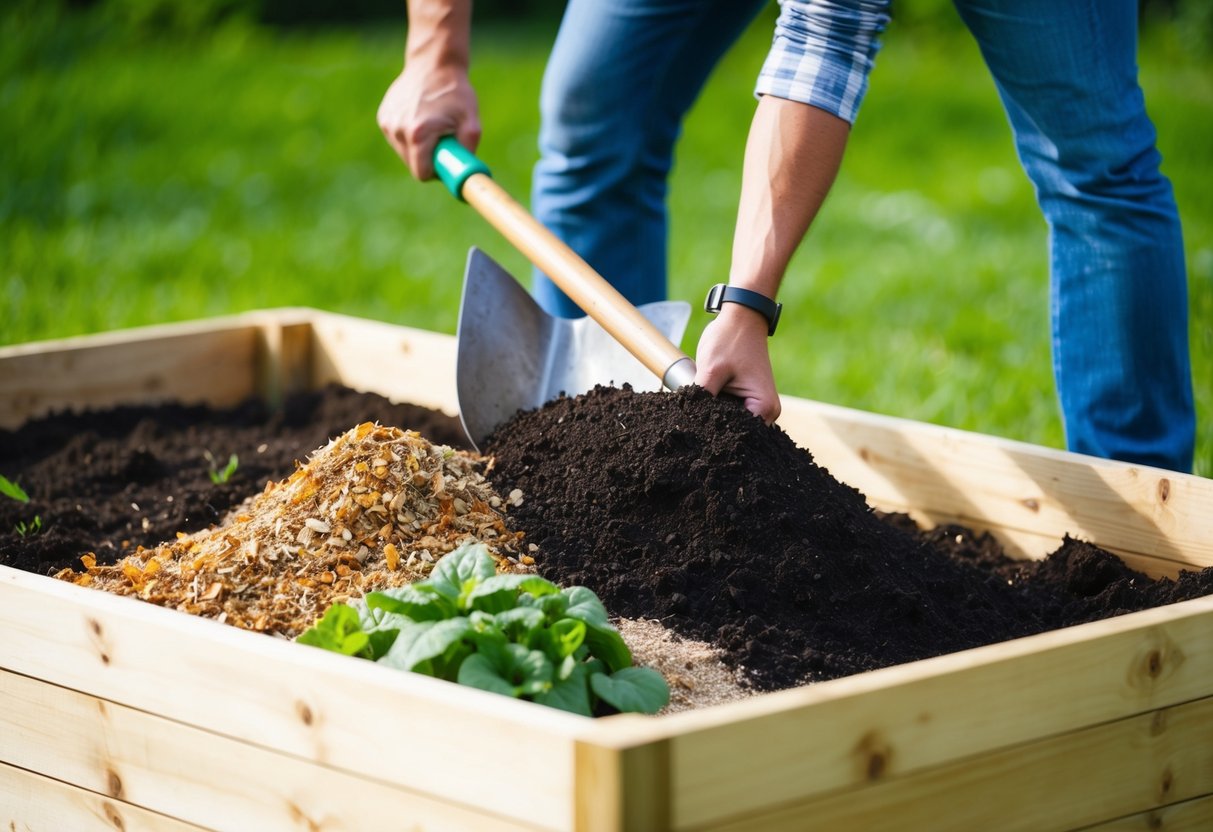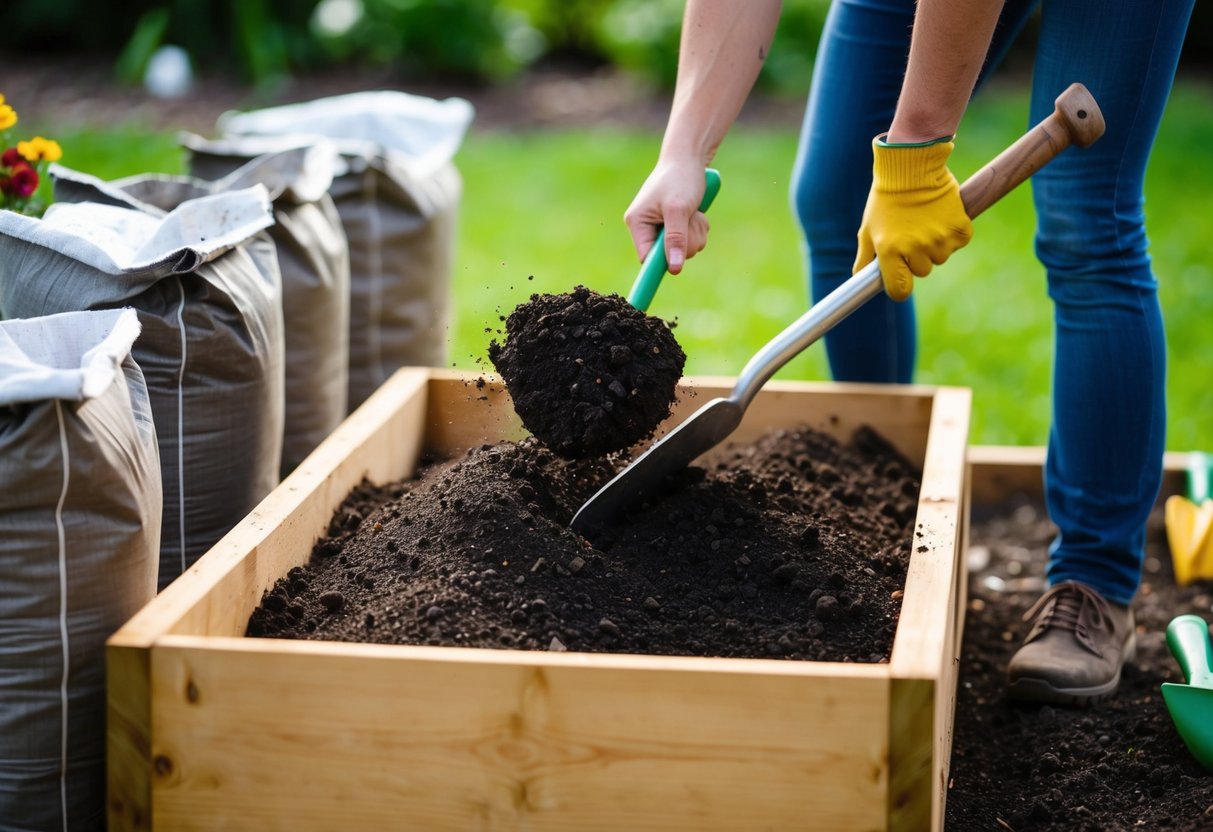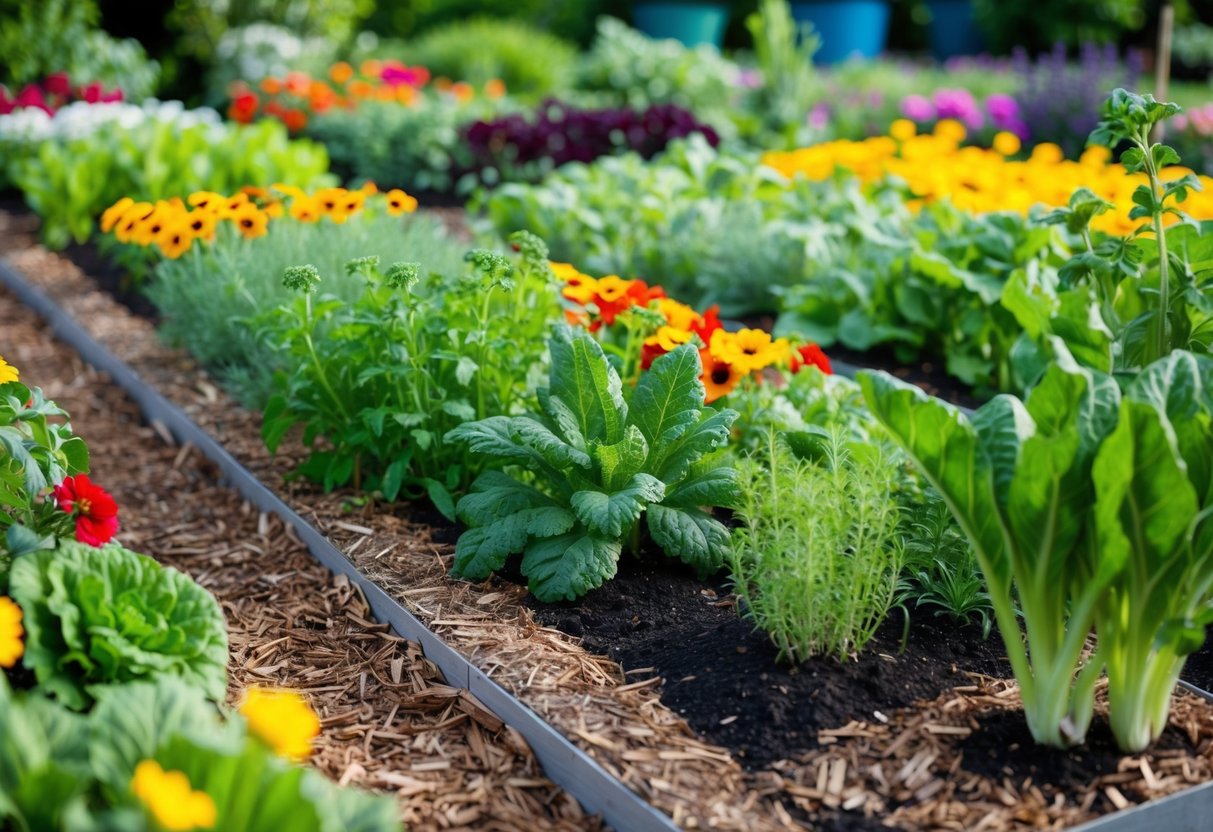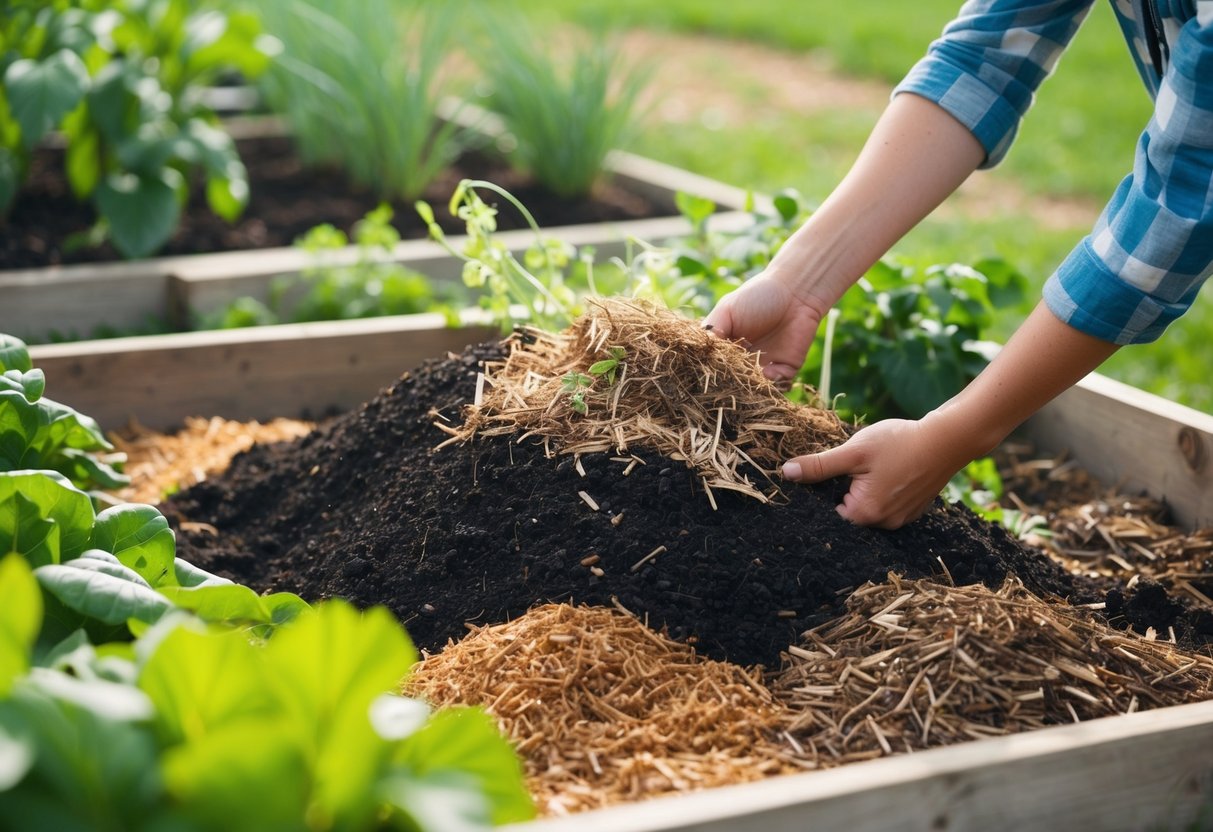What is the Best to Put in a Garden Bed? Top Tips for Lush Growth
Creating the perfect raised garden bed starts with knowing what to put at the bottom. Different materials can provide the right balance of nutrients, ensure good drainage, and prevent annoying pests. To get the best results, consider using a mix of cardboard, newspapers, and natural items like branches and leaves to line the bottom of your garden bed.

These materials break down over time and improve the soil quality, giving your plants the nutrients they need to thrive. Adding organic materials like coffee grounds or kitchen scraps can also contribute to rich, healthy soil. This approach not only saves you money but also helps recycle materials you might otherwise toss away.
For added protection against pests, include a layer of wide-mesh hardware cloth. This can keep out unwanted visitors like gophers while still allowing water to drain properly. With this setup, your raised garden bed will provide an ideal environment for your plants to flourish and grow robustly.
Planning Your Garden Bed Layout

Creating a successful garden bed requires careful planning. You need to think about the best location, choose suitable materials for your raised beds, and determine the size and number of beds you’ll need. Each of these factors contributes to the health of your plants and the ease of maintaining your garden.
Selecting the Right Location
When choosing a location for your raised garden bed, sunlight is a top priority. Find a spot that receives at least six to eight hours of sunlight each day. This is crucial for plants’ growth. Ensure the area is level to prevent water from pooling in one spot, which can harm garden soil.
Proximity to a water source also matters. You’ll want a location close enough for easy watering without dragging hoses around. Avoid low-lying areas where rainwater collects, as too much water can lead to root rot. A well-drained spot will help keep your plants healthy.
Choosing Your Raised Bed Materials
Selecting the right materials for your raised bed is important for durability and plant health. Wood is a popular choice; cedar and redwood are naturally rot-resistant and safe for gardening. If you prefer metal, galvanized steel is sturdy and long-lasting but might require liners to prevent soil contamination.
Plastic or composite materials are also popular. They’re generally lightweight and weather-resistant, making them a low-maintenance option. Make sure any material you choose is untreated and safe for planting to avoid leaching harmful chemicals into your garden soil.
Sizing and Number of Beds
The size and number of raised beds depend on your available space and gardening goals. Common sizes are 4×4 or 4×8 feet, which are manageable and allow you to reach the center easily. Keep beds no more than 3-4 feet wide, so you can access all plants without stepping on the soil.
Decide on the number of beds based on how much you plan to grow. You might start small and expand over time as you gain experience. Having multiple beds can help organize different types of plants, making it possible to rotate crops easily and maintain healthy soil.
Building the Base for Your Raised Beds

You want a strong base when setting up your raised beds. The right materials can help with drainage, stop weeds, and keep pests away. A good foundation makes planting easier and helps your plants grow better.
Importance of Drainage
Drainage is key to avoid waterlogging your garden beds. Without proper drainage, soil can become too wet, leading to root rot. Using materials like gravel or coarse sand at the bottom can help water flow through. This layer lets water drain away, keeping the roots healthy. Avoid packing the bottom tightly, as that can block water movement. Make sure excess water has an escape route, possibly through small holes at the bottom.
Layering Materials
Layering is important for a successful garden bed. Start with a base layer of cardboard to smother weeds and keep the earth damp. On top of that, add organic materials like compost or well-rotted manure. These materials break down over time, adding nutrients to the soil. For a richer mix, include topsoil mixed with additional compost. It might be helpful to add landscape fabric if you want to separate different types of soil. Ensure that the materials are evenly spread out.
Barrier against Weeds and Pests
A good barrier stops weeds and pests from reaching your plants. Using cardboard or newspaper at the base helps block sunlight, preventing weeds from growing. To keep pests like moles or voles out, you might want to use a layer of hardware cloth. Place it on the bottom before adding other layers. Landscape fabric is another option to act as a weed barrier. This also keeps unwanted plants from sprouting through the surface.
Selecting Soil and Compost for Raised Beds

Choosing the right soil and compost for your raised beds can make a big difference in how your plants grow. A good soil mix includes balanced nutrients, organic materials, and proper drainage. It also supports the long-term health of your plants.
Mixing the Ideal Soil Blend
To create the best soil mix for raised beds, combine different types of soil and organic materials. Topsoil and compost are key ingredients for making a nutrient-rich blend. A common recommendation is a mix of about 75% topsoil with 25% compost. This combination improves soil quality and offers the right balance of nutrients and texture.
Using loam soil as part of your blend can also be beneficial. Loam offers a good balance of clay, silt, and sand. Each type of soil brings its own benefits. Sand helps with drainage, while clay holds moisture. Silt offers a middle ground, providing nutrients for healthy plant growth.
Nutrients and Organic Matter
Adding nutrients and organic matter into your soil is crucial for plant health. Compost is a wonderful source of organic matter. It enriches the soil with essential nutrients like nitrogen, phosphorus, and potassium. These are vital for the growth of fruits, vegetables, and flowers.
Other options include aged manure or leaf mold, both of which can boost nutrient content. Organic matter also encourages the presence of beneficial microorganisms in your soil. These organisms break down organic materials, making nutrients easier for plants to absorb. Your plants will benefit from this nutrient-rich environment.
Maintaining Soil Health
Maintaining soil health over time ensures good plant growth season after season. Rotate crops each year to prevent nutrient depletion and reduce pest and disease problems. Crop rotation helps maintain balance in your soil, allowing plants to get a varied mix of nutrients.
Regularly topping up your raised beds with fresh compost or organic matter is important. It replenishes nutrients and supports healthy soil structure. Keep an eye out for soil compaction, which can limit plant growth. Aerating your soil or adding materials like perlite can help improve drainage and airflow, keeping your raised beds in top condition.
Planting and Managing Your Garden

Planting in raised beds offers many benefits, including better control over soil quality and drainage. It’s important to choose the right plants for your climate, ensure proper spacing for healthy growth, and use effective watering and mulching strategies to support plant health and moisture retention.
Choosing Plants for Your Climate
Start by researching which plants thrive in your area. Local nurseries and extension offices can be great resources. Leafy greens like spinach and lettuce often do well in a variety of climates and have a shorter growing season, making them ideal for beginners. Check the hardiness zones specific to your region to decide the best time to plant.
It’s important to pick plants that match your garden’s sunlight exposure. Some vegetables need full sun, while others, like leafy greens, can tolerate partial shade. Knowing these preferences helps you maximize yields and maintain strong plant health throughout the seasons.
Spacing and Planting Techniques
Proper spacing in your garden bed is crucial for healthy plants. Overcrowding can lead to competition for resources, which weakens plants and makes them susceptible to pests. For example, give your leafy greens enough room to spread their leaves. Use seed packets or plant labels as guides for spacing.
Consider using companion planting techniques. Pairing plants that benefit each other can improve growth and deter pests. Such combinations can help with nutrient uptake and minimize the need for chemical treatments, which is better for the environment and your garden ecosystem.
Watering and Mulching Strategies
Marry the right watering and mulching strategies for a thriving garden. Raised beds often need more frequent watering due to better drainage. Water deeply, but less often, to encourage strong root growth. Early morning or late evening is the best time to water, reducing evaporation and maximizing moisture retention.
Mulching is key for retaining moisture and suppressing weeds. Use organic materials like straw or wood chips, covering soil with a 3-4 inch layer. This not only helps with moisture retention but also adds nutrients back into the soil as it breaks down. Regularly check moisture levels, adjusting your approach based on weather changes to maintain a healthy garden.
Sustainable Practices for Long-term Success

To achieve long-term success in your garden bed, consider practicing sustainable methods. These include using organic waste, suppressing weeds naturally, and promoting a healthy ecosystem. By focusing on these approaches, your garden can thrive while minimizing environmental impact.
Incorporating Organic Waste
Using organic waste in your garden beds can lead to healthier soil. Items like kitchen scraps, grass clippings, and dry leaves can be transformed into nutrient-rich compost. Compost helps improve soil structure and provides essential nutrients for plants. Instead of throwing away your kitchen scraps, mix them into a compost bin. Over time, this decomposes into a rich fertilizer that supports plant growth without chemical inputs.
Grass clippings can also be used as mulch. Place a thin layer over your soil to retain moisture and add organic matter. Dry leaves serve similarly, breaking down to enrich soil content. By recycling what you already have, you reduce waste and enhance your garden’s sustainability.
Natural Weed Suppression
Suppressing weeds naturally involves more than just pulling them by hand. One effective method is using mulch, such as grass clippings or shredded leaves. A layer of mulch blocks sunlight, preventing weed growth. Plus, as mulch breaks down, it enriches the soil.
Consider planting densely, as this crowds out weeds. Close planting minimizes open space where weeds can thrive. Select ground covers like clover to fill in gaps. These covers reduce weed emergence and add nitrogen to the soil, fostering healthier growth for other plants. By maintaining a thick layer of mulch and strategic crop arrangement, you keep weeds at bay.
Promoting a Healthy Ecosystem
Creating a healthy ecosystem in your garden involves encouraging biodiversity. Plant a mix of flowers, vegetables, and herbs to attract beneficial insects. Bees, butterflies, and ladybugs can aid in pollination and reduce pest populations naturally. By encouraging a diverse range of species, you balance the ecosystem, resulting in thriving plant life.
Rotating crops each season helps prevent pest build-up and maintains soil health. Use companion planting, where specific plants support each other’s growth. For example, tomatoes and basil grow well together and aid each other in disease resistance. Incorporate these strategies to strengthen your garden’s natural ecosystem.







